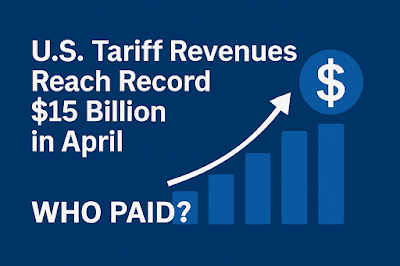Executive Summary
In April 2025, U.S. tariff revenues reached an unprecedented $15.4 billion, marking the highest monthly collection in American history. This surge was driven by the implementation of sweeping new trade policies under President Donald Trump's administration, including a universal 10% tariff on most imports and additional sector- and country-specific tariffs. While these measures have significantly boosted federal revenue, the burden of the tariffs falls squarely on American importers and, ultimately, U.S. consumers, not foreign countries.
Sources of Tariff Revenue
The $15.4 billion in tariff revenue collected in April 2025 stemmed from several key policy initiatives:
-
Universal 10% Tariff: Introduced on 5 April 2025, this tariff applied to nearly all imported goods except selected energy products and critical minerals.
-
Country-Specific Tariffs: From 9 April 2025, additional tariffs targeted imports from approximately 60 countries, based on perceived unfair trade practices.
-
Sector-Specific Tariffs: New 25% tariffs were imposed on imported automobiles, auto parts, and reinstated for imported steel, significantly affecting major industries.
These tariffs caused a more than 60% increase in customs collections compared to the previous month.
Who Pays the Tariffs?
Despite political rhetoric suggesting that foreign nations bear the cost of tariffs, factual economic analysis shows that it is U.S. importers who pay tariffs directly at the point of entry. These costs are often passed on to American consumers in the form of higher retail prices. Major U.S. companies, including Target, Shein, Ford, and Volkswagen, have indicated that the tariffs are compelling them to raise prices on a broad range of products.
Impact on Foreign Countries
It is important to emphasise that foreign countries are not financially impacted by U.S. tariffs themselves. Their primary exposure is the potential reduction in sales volumes due to higher retail prices in the United States, making their goods less competitive. However, they do not directly pay the tariffs.
Some foreign governments have responded with reciprocal tariffs on U.S. exports, leading to higher costs for American goods abroad. This dynamic has the potential to affect U.S. farmers, manufacturers, and exporters by making their products less attractive in global markets.
Historical Context: Tariffs as a Response to U.S. Subsidies
Historically, several countries have implemented tariffs or trade barriers in response to U.S. policies such as agricultural subsidies. For example, U.S. government subsidies to American farmers have long been a source of trade friction. Foreign governments have argued that such subsidies distort global agricultural markets by giving American farmers an artificial competitive advantage. In response, some countries have introduced tariffs on U.S. agricultural products to offset these advantages and create a more level playing field. These reciprocal measures are intended to protect domestic industries from what they perceive as unfair competition resulting from U.S. internal economic policies.
Economic Implications
-
Consumer Prices: Higher import costs have contributed to increased consumer prices across various sectors.
-
Inflationary Pressure: The tariffs risk adding inflationary pressure to an economy already sensitive to price increases.
-
Trade Relations: The imposition of tariffs and subsequent retaliations strain diplomatic and economic relations with key trading partners.
-
Growth Concerns: Economists warn that prolonged high tariffs could dampen economic growth and elevate recession risks if consumer spending contracts.
Conclusion
While the U.S. government has achieved a record-breaking boost in tariff revenue, the economic reality is that American businesses and consumers bear the brunt of these tariffs. Foreign exporters may experience reduced sales, but they are otherwise unaffected financially unless reciprocal trade actions are taken. The full long-term impact on the U.S. economy, including inflation, growth, and international trade relationships, will depend on how these policies evolve in the coming months.

No comments:
Post a Comment